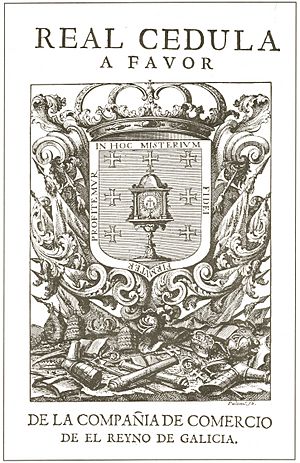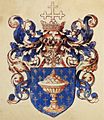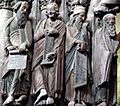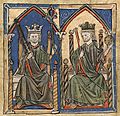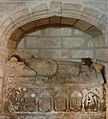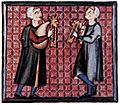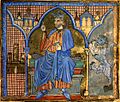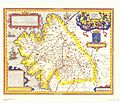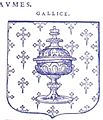Kingdom of Galicia facts for kids
Quick facts for kids
Kingdom of Galicia
|
|||||||||||||
|---|---|---|---|---|---|---|---|---|---|---|---|---|---|
| 409–1833 | |||||||||||||
|
Motto: Hoc hic misterium fidei firmiter profitemur
"Here is the mystery of faith that we strongly profess" |
|||||||||||||
|
Anthem: Antiga Marcha do Reino de Galicia
|
|||||||||||||
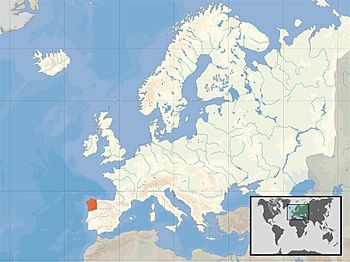
The location of the Kingdom of Galicia in the 11th century CE, in red
|
|||||||||||||
| Capital | Santiago de Compostela1 | ||||||||||||
| Common languages | Latin Vulgar Latin Galician-Portuguese Astur-Leonese Castilian A few speakers of Brittonic, Visigothic, Vandalic and Suebic |
||||||||||||
| Religion | Roman Catholicism | ||||||||||||
| Government | Monarchy | ||||||||||||
| Monarch | |||||||||||||
|
• 409–438
|
Hermeric (first) | ||||||||||||
|
• 1813–1833
|
Ferdinand VII (last) | ||||||||||||
| Legislature | Junta | ||||||||||||
| History | |||||||||||||
|
• Founded by Hermeric
|
409 | ||||||||||||
|
• Dissolved
|
1833 | ||||||||||||
|
|||||||||||||
The Kingdom of Galicia was an important kingdom in the Iberian Peninsula (where modern-day Spain and Portugal are) during the Middle Ages. It existed in two main periods.
First, it was a state ruled by the Suebi, a Germanic people, from 409 to 584 CE. This kingdom was in the same area as the old Roman province of Gallaecia.
Later, the region of Galicia became independent again in 910 CE. It kept its independence off and on for over 200 years. Finally, in 1157, it joined with the Kingdom of León and stayed united with it after that.
Contents
The Suebic Kingdom: Galicia's First Independent Era
The Suebic Kingdom in Gallaecia lasted from 410 to 584 CE. For much of this time, it had a fairly stable government. Historians believe that only about 30,000 Suebic people invaded the area. This was a small number compared to the local population.
In 438, Hermeric, the Suebic King, made peace with the local Hispano-Roman people. Tired of fighting, he gave up his throne to his son, Rechila. Around this time, the Visigoths invaded the Iberian Peninsula. They were sent to fight other groups like the Vandals and Alans. This actually helped the Suebi Kingdom grow bigger.
In 448, Rechila died. His son, Rechiarius, became king. Rechiarius had converted to Roman Catholicism around 447. This made Catholicism the official religion of the kingdom, moving away from the old pagan beliefs of the Suebi.
However, in 456, Rechiarius was defeated by the Visigoth king Theodoric II. After this, the Suebic Kingdom began to lose its power. It was pushed into the northwest part of the peninsula. Political problems also arose, with two different kings ruling on opposite sides of the Minius River (Miño).
Despite pressure from the Visigoths, the Suebi kept their independence in the northwest until 584. In that year, the Visigoth King Leovigild took over the Suebic Kingdom. He used a conflict over who would be the next king as an excuse. Andeca, the last Suebic king, fought for a year but surrendered in 585.
The Kingdom of Galicia and Portugal: A Brief Union
The Kingdom of Galicia and Portugal was formed in 1065. This happened after the County of Portugal declared its independence. Portugal's ruler, Count Nuno II Mendes, took advantage of a civil war among the sons of Ferdinand I of Castile. Ferdinand I had divided his kingdom among his sons in 1063, giving Galicia to García.
Nuno II Mendes tried to make Portugal fully independent. However, in 1071, King García defeated and killed him at the Battle of Pedroso. García then added the title of King of Portugal to his own.
But García's rule didn't last long. In 1072, his brother Sancho II of Castile defeated him, and García had to flee. Later that year, after Sancho was killed, Alphonso VI became king of León and Castile. He reunited his father's lands. From then on, Galicia remained part of the kingdom of Castile and León. It had different levels of self-government over time. Even though this combined kingdom was short-lived, it helped set the stage for Portugal to become its own nation later.
Leonese Kings and Galicia's Future
At the Battle of São Mamede in 1128, Afonso I of Portugal defeated the troops led by Count Fernando Peres de Trava of Galicia. Afonso made his own mother a prisoner and sent her to a monastery in León. This event ended the idea of Portugal joining a larger Kingdom of Galicia. Afonso became the sole ruler, known as the Dux of Portugal.
Images for kids
-
Arms of the Kingdom of Galicia, illustrated in L´armorial Le Blancq, Bibliothèque nationale de France, 1560
-
Theodemar (or Ariamir), king of Galicia with the bishops Lucrecio, Andrew, and Martin. Codex Vigilanus (or Albeldensis), Escurial library
-
Miro, king of Galicia, and Martin of Braga, from an 1145 manuscript of Martin's Formula Vitae Honestae, now in the Austrian National Library. The book was originally dedicated to King Miro with the header "To King Miro, the most glorious and calm, the pious, distinguished for his Catholic faith"
-
Monastery of San Pedro de Rocas, Galicia, founded in 575 and inhabited until the early 20th century
-
Political map of southwestern Europe around the year 600, which referred to three different areas under Visigothic government – Hispania, Gallaecia, and Septimania
-
Tombstone of the sepulcher of bishop Theodemar of Iria (d. 847), discoverer of the tomb attributed to apostle Saint James the Great
-
Statue of Vímara Peres, conqueror of Porto in 868
-
Modern replicas of Viking ships by the castle of Torres de Oeste, Catoira
-
Pórtico da Gloria, Cathedral of Santiago de Compostela
-
Medieval miniatures of Ferdinand II (left) and Alfonso IX (right), kings of León and Galicia. Chartulary of the monastery of Toxosoutos, Lousame, 13th century
-
Miniatures from a manuscript of the Cantigas de Santa Maria
-
Paio Gómez Chariño's Tomb, Convent of San Francisco, Pontevedra, Galicia
-
Battle of Nájera. Galician armies fought with Pedro I and Edward of Woodstock, defeating the Castilian armies of Henry of Trastámara
-
John of Gaunt entering Santiago de Compostela, from a manuscript of Jean Froissart's chronicles
-
Castle of the House of Andrade, A Nogueirosa, Pontedeume
-
The castle of Pambre, Palas de Rei, which resisted the Irmandiños troops
-
Castle of Soutomaior
-
Flag and arms of the Kingdom of Galicia (16th century), after the funeral of Emperor Charles V, also king of Galicia, by Joannes and Lucas Doetecum
-
The reign of Philip II of Habsburg saw a deep economic and social crisis, and was disastrous for its cultural development; portrait by Alonso Sanchez Coello
-
Diego Sarmiento de Acuña, count of Gondomar, was one of the main advocates of voting rights at the Council of Castile. A humanist ambassador and lover of the Galician language and culture, he was respected and appreciated in the kingdom and abroad; c. 17th century
-
Portrait of Martín Sarmiento
-
Romanesque miniature representing Alfonso IX, King of León. In the upper part appears his historic title Rex Legionensium et Gallecie, while the lower part shows the purple lion, symbol of the Leonese monarchy
-
Monastical church of San Miguel de Eiré, Pantón (12th century)
-
Pórtico da Gloria, Cathedral of Santiago de Compostela (12th–13th centuries), summum of the local Romanesque sculpture
-
Sepulcher of count Pedro Fróilaz de Traba (Orbem Galletie Imperante), protector of king Alfonso VII (d. 1128)
-
Sepulcher of king Ferdinand II (Rex in Legione et Gallecia) (d. 1187)
-
Sepulcher of Ferdinand of Galicia and León. Son and heir of the king Afonso VIII (known as alfonso ix in the Spanish bibliography) (d. 1214)
-
Sepulcher of the queen Berengaria of Barcelona wife of Afonso VII (d. 1149)
-
Sepulcher of king Afonso VIII of León and Galicia (known as Afonso IX in the Spanish bibliography) (Rex Legionis et Gallecie) (d. 1230)
-
Sepulcher of queen Joana de Castro of Castilla, León, Toledo and Galicia (d. 1374)
-
Arms of the Kingdom of Galicia, illustrated in L´armorial Le Blancq, Bibliothèque nationale de France, 16th century
-
Burgo de Osma´s map (1086), with the names Gallecia (occupying the whole Northwest Iberian Peninsula), Asturias (occupying the Cantabrian linecoast), and Spania (occupying the rest of Iberia)
-
In Tabula Rogeriana (1154), by Muhammad al-Idrisi, showing the name Ard Galika
See also
 In Spanish: Reino de Galicia para niños
In Spanish: Reino de Galicia para niños





